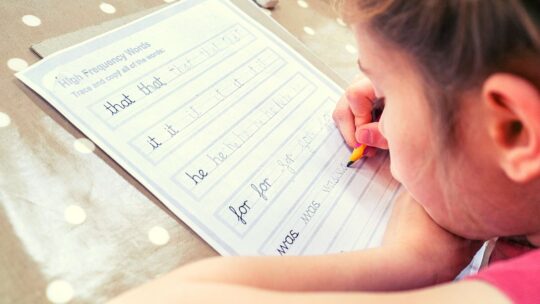
Whether you’re worried about a child’s printing or cursive writing, rest assured, there are strategies you can use to help him out. As the old saying goes, “Practice makes perfect!” There’s no need to aim for perfection, but the practice is undoubtedly a great starting point if your child is struggling with writing. There are handwriting worksheets your child can complete to support their printing development. If the difficulties are with cursive, cursive worksheets with a focus on letter formation and linking letters together can be helpful.
It’s essential to keep writing practice light and fun. It shouldn’t seem like a never-ending chore. Think about a task that you’re not particularly good at. Being asked to practice something that you find very difficult, frequently and for long periods of time, would not make you happy! It would also not keep you motivated and excited about learning. Keep this in mind when it comes to having your child practice her writing. Depending on her age, ten minutes of practice may be just enough. Older children may be able to maintain their focus and attention for more extended periods.

When you’re learning a new skill, what do you find helpful? Chances are, you need to see the skill modeled. The same goes for writing! Show your child how to form the letters, several times, before asking him to try. It may also be beneficial to teach your child a verbal pathway to recite when making letters. For example, to help remember how to print a lowercase “j,” teach your child the phrase, “Pull down, curve around, dot.” Then, make sure your child has a model of the letter to use as a reference. Seeing you form the letter, hearing the verbal pathway, and having a model to look at will help your child improve his writing.
Along with letter formation, children need to give consideration to spacing. Forming the letters correctly is excellent, but if they are crowded together, written diagonally across the page, or too small to read or so big they don’t fit on the lines, their handwriting can become messy and even illegible. Worksheets that provide lines for children to write on can help them write in a straight line, left to right, with a distinction between tall and short letters. Young children may also need to practice the concept of “finger space” to leave adequate space between their words.

As your child’s letter formation and spacing become more proficient, you can introduce some authentic writing activities for further practice. For example, your child might enjoy writing letters back and forth with a friend or relative. Younger children might like drawing pictures then adding labels to them. Perhaps your child would like the job of adding something to the grocery list. If you are sending someone a birthday card, have your child sign her own name on the card. Ditto for sending Valentines! Maybe she can practice writing letters by making a word search. Older children might like writing stories, poems, or even jokes!
If writing continues to be a struggle for your child despite your best efforts, it can be helpful to speak to a professional. An occupational therapist can assess your child’s fine motor skills and offer further recommendations to support his development. If the difficulties he experiences with writing spill over into other fine motor activities, like cutting, using utensils, or doing up buttons, helpful information to share with the occupational therapist. He/she will create a plan to support your child’s success.























